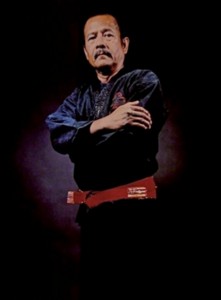Kajukenbo was founded in 1947 in the Palama Settlement on Oahu, Hawaii. In the late 1940s, the Palama Settlement was a violent area. Due to this environment, five martial artists from varying backgrounds came together with the goal of developing an art that would be practical and effective on the street. These founders sought to develop one style that would complement each of their individual styles and yet allow for effective fighting at a greater variety of ranges and speeds.
The five founding members of Kajukenbo were:
Adriano Directo Emperado — Kenpo (Kosho Ryu) and Eskrima
Joseph Holck — Judo and Danzan Ryu Jujutsu
Peter Young Yil Choo — Tang Soo Do Korean Karate and Boxing
Frank F. Ordonez — Danzan Ryu Jujutsu
Clarence Chang — Sil-Lum Pai Kung Fu
In its conception, the founders followed a simple rule, if a technique worked consistently on the street (or against one another), then it stayed in the system, if it did not, it was discarded. This allowed the style to maintain its self-defense focus, while covering limitations found within each of their traditional arts.
Shortly after its conception, the Korean War broke out, and with it Joe Holck, Peter Choo, Frank Ordonez, and Clarence Chang left Hawaii on active military service, leaving only Adriano Emperado to continue teaching the system.
Emperado and his brother Joe introduced Kajukenbo to the public by opening the Palama Settlement School in 1950. They called the school the ‘Kajukenbo Self Defense Institute’ (K.S.D.I.). The training there was notoriously brutal. Their goal was to be invincible on the street, thus the students sparred with full contact. Emperado had a motto, “The workout isn’t over until I see blood on the floor”. He also said “the best teacher is pain”. His philosophy was that if someone was afraid of pain they would be defeated the first time they were hit. Those who remained developed into tough fighters with a reputation for employing their art in street fights with little provocation.
In 1959, Emperado continued to add more Kung Fu into Kajukenbo, shifting the art to a more fluid combination of hard and soft techniques. Since then, Kajukenbo has proved to be an improvement-based, continuously evolving and open form. John Leoning, also helped bring out the “bo” of Kajukenbo by pointing out that there should be no wasted motion.
The art slowly began to grow in popularity, and soon Emperado had 12 Kajukenbo schools in Hawaii, making it the second largest string of schools at the time. Joe Halbuna, Charles Gaylord, Tony Ramos and Aleju Reyes, who all earned a black belt from Emperado, brought Kajukenbo to the U.S. mainland in 1960. They each opened Kajukenbo schools in California.
